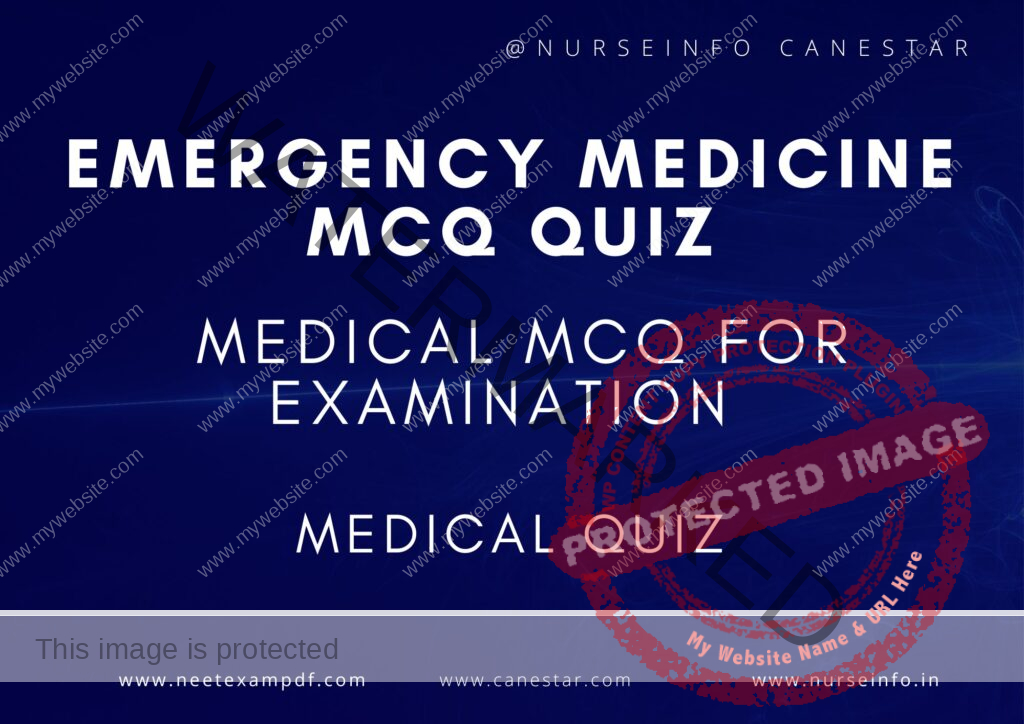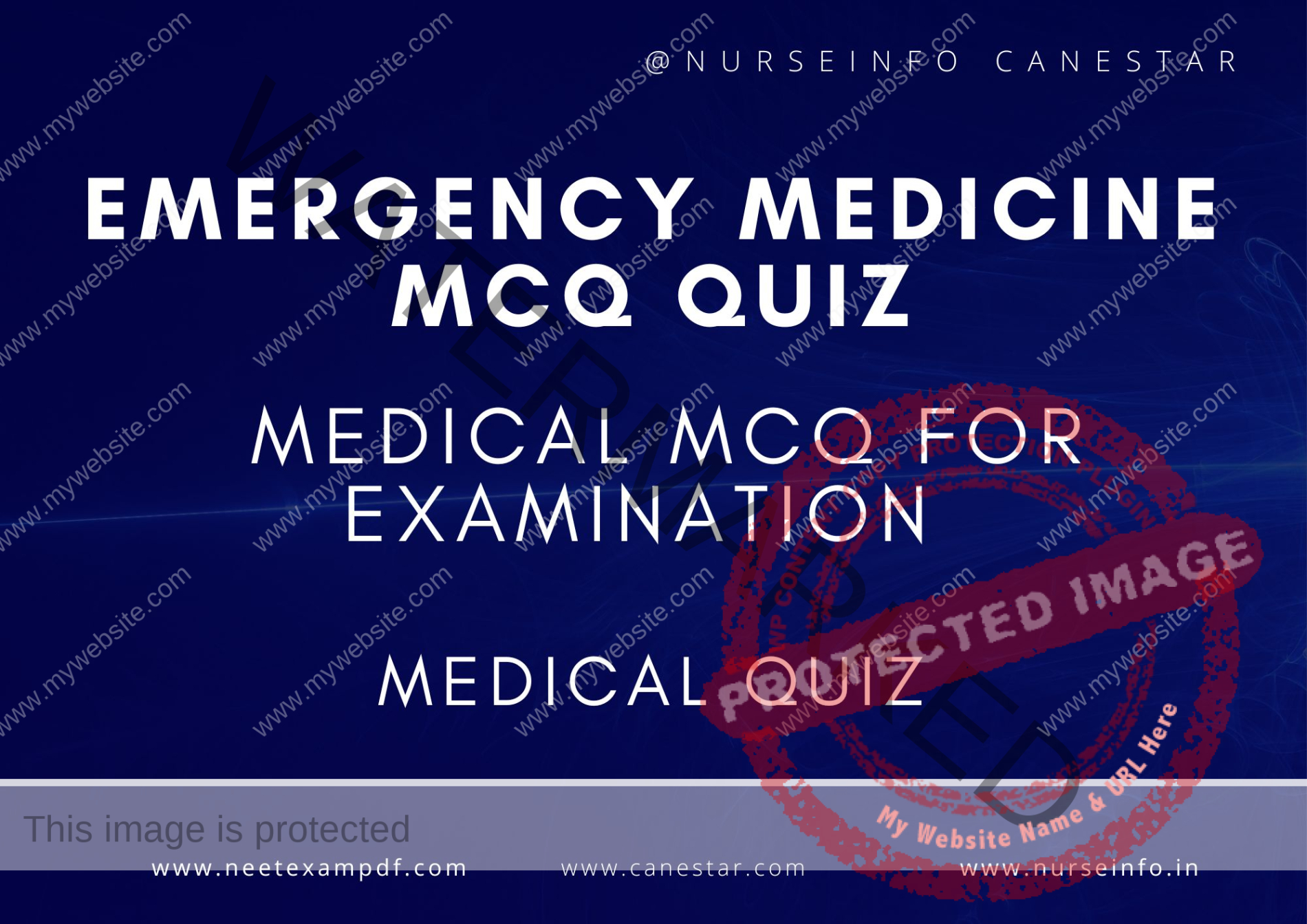MULTIPLE CHOICE QUESTIONS ON EMERGENCY MEDICINE QUIZ – MCQS WITH RATIONALE ANSWER – EMERGENCY MEDICINE MCQ QUESTIONS WITH RATIONALE
MCQ FOR EMERGENCY MEDICINE QUIZ
These mcqs are prepared exclusively for medical professionals for exam preparation. MCQ is helpful to remember the concept on emergency medicine mcq quiz. This multiple choice questions are helpful for preparation for DHA, PROMETRIC, MOH, HAAD, NCLEX, Medical, NEET and Nursing EXAMINATION
EMERGENCY MEDICINE MCQ QUIZ
Emergency Medicine MCQs with Rationale
Which of the following is the most appropriate first step in managing a patient with suspected cardiac arrest?
a) Check for a pulse
b) Administer oxygen
c) Start chest compressions
d) Call for help
Answer: d) Call for help
Rationale: The first step is to call for help to ensure that additional resources are mobilized while beginning resuscitation efforts.
What is the primary purpose of administering epinephrine in an anaphylactic reaction?
a) To reduce fever
b) To decrease blood pressure
c) To counteract bronchoconstriction and vasodilation
d) To promote fluid retention
Answer: c) To counteract bronchoconstriction and vasodilation
Rationale: Epinephrine rapidly reverses the symptoms of anaphylaxis by reducing bronchoconstriction and vasodilation, improving breathing and stabilizing blood pressure.
Which symptom is most indicative of a tension pneumothorax?
a) Dull chest pain
b) Sudden, sharp chest pain with dyspnea
c) Bilateral lung crackles
d) Gradual onset of chest tightness
Answer: b) Sudden, sharp chest pain with dyspnea
Rationale: A tension pneumothorax presents with sudden, sharp chest pain, severe dyspnea, and signs of respiratory distress due to trapped air causing pressure on the lung.
In a trauma patient with suspected spinal injury, what is the most important initial action?
a) Administering pain medication
b) Immobilizing the cervical spine
c) Performing a neurological exam
d) Taking vital signs
Answer: b) Immobilizing the cervical spine
Rationale: Immobilizing the cervical spine is crucial to prevent further injury to the spinal cord until the extent of the injury can be assessed.
What is the preferred site for intraosseous (IO) access in an emergency situation?
a) Humerus
b) Femur
c) Tibia
d) Radius
Answer: c) Tibia
Rationale: The tibia, specifically the proximal tibia, is the most commonly used site for intraosseous access due to its accessibility and large marrow cavity.
Which drug is commonly administered for the rapid control of severe hyperkalemia?
a) Furosemide
b) Calcium gluconate
c) Metoprolol
d) Digoxin
Answer: b) Calcium gluconate
Rationale: Calcium gluconate is administered to stabilize the cardiac membrane in severe hyperkalemia, reducing the risk of life-threatening arrhythmias.
What is the initial management for a patient presenting with acute myocardial infarction (MI)?
a) Administering aspirin
b) Performing an echocardiogram
c) Starting a beta-blocker
d) Giving a diuretic
Answer: a) Administering aspirin
Rationale: Administering aspirin is a priority as it helps inhibit platelet aggregation and reduce the severity of an acute myocardial infarction.
Which of the following is the most reliable sign of airway obstruction in an unconscious patient?
a) Cyanosis
b) Snoring or gurgling sounds
c) Tachycardia
d) Hypertension
Answer: b) Snoring or gurgling sounds
Rationale: Snoring or gurgling sounds indicate partial airway obstruction due to the tongue or foreign material in the airway, requiring immediate intervention.
What is the most important diagnostic tool for evaluating a patient with suspected stroke?
a) Electroencephalogram (EEG)
b) Blood glucose level
c) CT scan of the head
d) Lumbar puncture
Answer: c) CT scan of the head
Rationale: A CT scan of the head is essential to differentiate between ischemic and hemorrhagic stroke and guide appropriate treatment.
In the management of a patient with sepsis, which of the following is a key early intervention?
a) Administering high-dose steroids
b) Performing a lumbar puncture
c) Initiating broad-spectrum antibiotics
d) Giving beta-blockers
Answer: c) Initiating broad-spectrum antibiotics
Rationale: Early administration of broad-spectrum antibiotics is critical in sepsis management to combat the underlying infection and reduce mortality.
What is the immediate treatment for a patient with suspected opioid overdose?
a) Activated charcoal
b) Naloxone administration
c) IV fluids
d) Mechanical ventilation
Answer: b) Naloxone administration
Rationale: Naloxone is an opioid antagonist that rapidly reverses the effects of opioid overdose, restoring normal respiration.
Which of the following is a common cause of acute abdomen requiring emergency surgery?
a) Cholecystitis
b) Peptic ulcer
c) Irritable bowel syndrome
d) Gastroenteritis
Answer: a) Cholecystitis
Rationale: Acute cholecystitis, or inflammation of the gallbladder, often requires emergency surgery to prevent complications such as perforation or sepsis.
In a patient with suspected acute stroke, what is the time window for administering thrombolytic therapy?
a) Within 1 hour of symptom onset
b) Within 3 hours of symptom onset
c) Within 6 hours of symptom onset
d) Within 12 hours of symptom onset
Answer: b) Within 3 hours of symptom onset
Rationale: Thrombolytic therapy is most effective when administered within 3 hours of stroke symptom onset, improving outcomes and reducing disability.
Which of the following is a sign of increased intracranial pressure (ICP) in a head injury patient?
a) Bradycardia
b) Hypotension
c) Tachypnea
d) Hypoglycemia
Answer: a) Bradycardia
Rationale: Bradycardia, along with hypertension and irregular respirations (Cushing’s triad), is a sign of increased intracranial pressure and impending herniation.
What is the most effective intervention to manage an acute asthma exacerbation?
a) Oral corticosteroids
b) Inhaled bronchodilators
c) IV fluids
d) Antibiotics
Answer: b) Inhaled bronchodilators
Rationale: Inhaled bronchodilators, such as albuterol, are the first-line treatment for rapid relief of bronchoconstriction in acute asthma exacerbations.
What is the first priority in managing a trauma patient with an open fracture?
a) Administering tetanus prophylaxis
b) Applying a sterile dressing
c) Immobilizing the fracture
d) Providing analgesia
Answer: c) Immobilizing the fracture
Rationale: Immobilizing the fracture helps prevent further injury and reduces pain, and is a crucial step in the initial management of open fractures.
Which of the following is a sign of hypovolemic shock?
a) Hypertension
b) Bradycardia
c) Tachycardia
d) Peripheral edema
Answer: c) Tachycardia
Rationale: Tachycardia is a compensatory response in hypovolemic shock, as the body attempts to maintain cardiac output despite reduced blood volume.
Which of the following medications is indicated for the treatment of acute coronary syndrome (ACS)?
a) Acetaminophen
b) Clopidogrel
c) Metformin
d) Albuterol
Answer: b) Clopidogrel
Rationale: Clopidogrel, an antiplatelet agent, is used in acute coronary syndrome to prevent further platelet aggregation and reduce the risk of myocardial infarction.
What is the initial management step for a patient with a suspected spinal cord injury?
a) Administering high-dose corticosteroids
b) Performing a neurological assessment
c) Immobilizing the spine
d) Ordering an MRI
Answer: c) Immobilizing the spine
Rationale: Immobilizing the spine is crucial to prevent further damage to the spinal cord in patients with suspected spinal injuries.
Which condition is characterized by severe chest pain, diaphoresis, and a sense of impending doom?
a) Gastroesophageal reflux disease (GERD)
b) Acute coronary syndrome (ACS)
c) Pneumonia
d) Costochondritis
Answer: b) Acute coronary syndrome (ACS)
Rationale: Acute coronary syndrome typically presents with severe chest pain, diaphoresis, and anxiety, often described as a sense of impending doom due to myocardial ischemia.


